Interviewed in Vienna, 23 June 2014
Peter Kogler is one of the rare artists whose works are daily seen by dozens of thousands of travellers and passers-by, but who is also the protagonist of artistic events held at exclusive European museums and galleries. His universal language of signs, often derived from everyday life, develops a specific idiosyncratic poetics. Sophisticated digital programmes are not used for their own sake, but their use results in the creation of unpredictable magical areas. Mostly it is about the estrangement of simple motifs (ant, brain, pipes), which results in surprise, and even shock. As the follower of American artists, Jackson Pollock, Donald Judd or Sol LeWitt, in his all over ideas Kogler denies any hierarchy, as well as the classicial principles of the composition in order to create his own world, often also realised in a virtual area.
Podrecca: You have probably discussed this before, but you are the only Tyrolian artist that I know of whose work shows no object, metaphor or recollection of landscape. Was there, perhaps, too much nature in your life so that your motifs – pipes, networks, etc. are a sort of a rebellion against landscape?
Kogler: I am not so sure that I am the only one; I think it is a phenomenon of my generation. Your words apply to the generation before ours; Pichler, Abraham and others had a powerful relationship with landscape. Landscape has a central position in their work. There are numerous artists of my generation in whose work such a relationship is hard to find, e.g. artists such as Ernst Caramelle or Martin Walde.
Podrecca: The question arises whether it was your decision, or were you overwhelmed by the events of the time? There is no milieu of landscape; there is no passe-partout, or a background to your work.
Kogler: Probably because art has always been my reference system for art. Especially, at least at first, American art, not so much European art, Austrian to an even lesser extent, and especially not regionally based art. My lack of connection with the Austrian tradition was undoubtedly related to the fact that the previous generation was so strongly present. I believe that Austrian Actionism was the most important phenomenon, and that there was nothing that could be added to the movement; that was a closed story.
Grimmer: Yet, your beginnings in the 1970s are connected with the performance art at the Krinzinger Galleries, at the time located in Innsbruck and St. Stefan in Vienna. What was the extent of the relation, or parallelism, or even opposition, towards the Viennese Actionism, the position which was extremely existentially oriented, even beyond the boundaries of the existential?
Kogler: The relation is more or less humorous. Actionism as a quotation, naturally; naked body at an exhibition, yet completely without psychoanalytic drama, and definitely without catharsis.
Grimmer: Without catharsis as the basic element of European art?
Kogler: Probably, especially in the Viennese tradition.
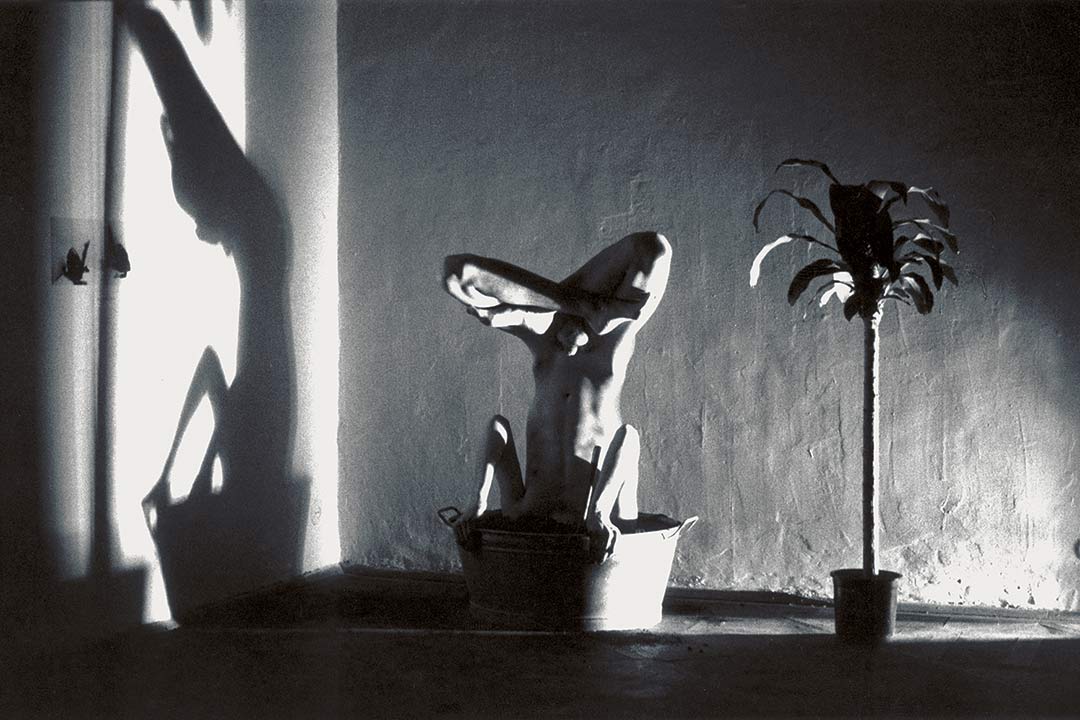
Grimmer: We can feel a distance in your work.
Kogler: There is a distance, but that was at the end of the 1970s; then the conceptual, performative approach emerged. In my generation nobody painted, painting returned in the 1980s.
Podrecca: I would also like to add that Viennese or Austrian art has always been psychoanalytical, while Peter Kogler’s work represents a demarcation line between art and science. A story is significantly bolder than the body, the soul, the flesh and the wound, the hidden Catholicism in the background, as with Nitsch or Brus. There is a thesis that art and science represent two separate poles. I believe that Kogler’s works loosen the boundary. There is a clear cut through the pixelisation of the work of art – I would say metaphorically – a new poetics which softens the boundary. It is a statement and, at the same time, a question which can be commented.
Kogler: I employ technology in my work, I try to be informed about the activities in the field of science, but I have to stress that science is science, and art is art.
Grimmer: They are separate areas, but activities in the field of science can be relevant for art.
Kogler: Exactly. In the 1980s I consciously decided to work with the computer. Back then it was absolutely clear that it is a medium which will completely determine the way we understand images, as well as their production.
Podrecca: It is this poetics of the demarcation line which determines the objects that have been constructed and exposed without the milieu; there is no murmur of the creek, there are no extra elements, the work has no passe-partout. The objects are what they are; constructed objects, a bulb, an ant… They are individual elements where the terms of art and science have been amalgamated. Are there any parallel elements in your work – the foreground, the background, the main topic, the secondary topic, are there sequences of these layers in your work, or are there always completely clear motifs, ideograms as I know them?
Kogler: It seems that there is a transparent visual vocabulary; over the years a kind of a visual language was developed, which consists of individual modules, and the meaning of these elements is changing depending on the context.
Podrecca: These pictograms, motifs are never specific in relation to the location.
Kogler: The idea is to develop a universal language.
Podrecca: There is no need for action in your solitary pictograms… Ideogram represents poetics in itself.
Grimmer: However when they are transferred in space, a milieu with specific relations is created.
Kogler: It is secondary; the visual vocabulary is in the foreground, e.g. the brain, and the second component is, doubtless, the relation towards architecture. I would like to mention that the history of the origin of the pictogram is related to the Viennese tradition. Otto Neurath’s intention was to communicate complex content with the help of a visual vocabulary, regardless of the social or cultural background.
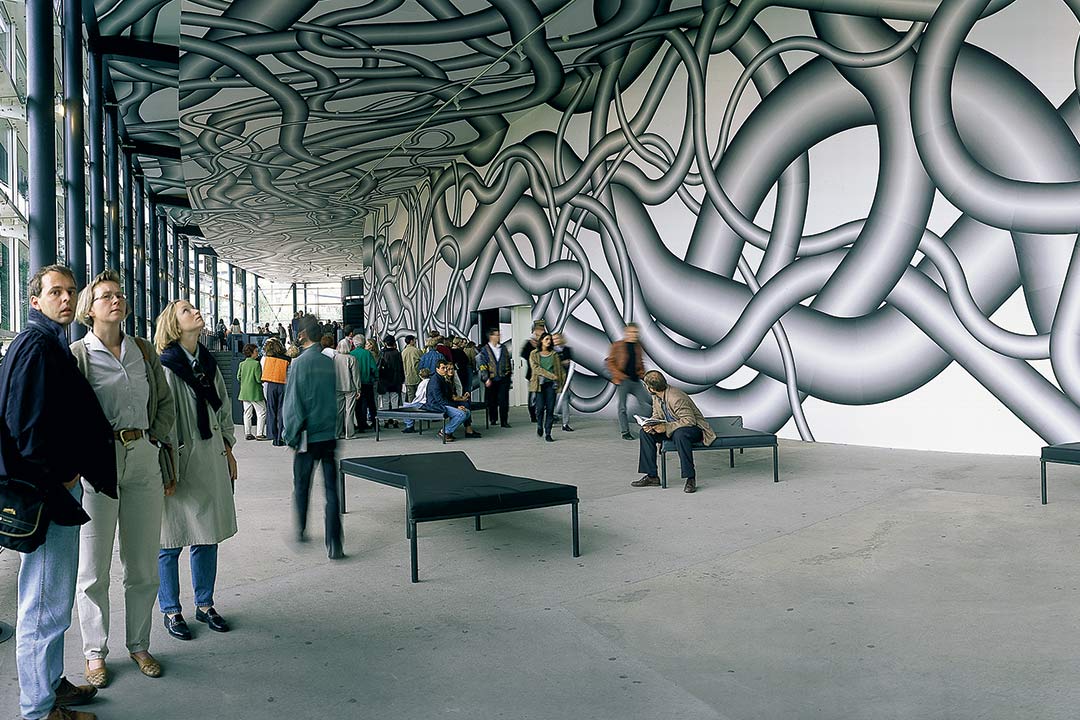
Podrecca: The idea of the contextual is interesting to us architects, whether we wanted it or not. We do not work in an empty space, or on a single surface. The milieu is always there – provoking us to create our work. What you are doing is, basically, the opposite from this architectural attitude, it is anti-contextuality.
Kogler: I would not say so. There is always a certain universal vocabulary, but it is developed specifically for one place, one project. It is not possible to transfer project A on a whim; a project always depends on a specific space. A subway station is completely different from a gallery or a school.
Podrecca: So, although object is individual, there is a contextual element.
Kogler: It is greatly harmonised with a specific location. Important parameters, such as the selection of motifs, or the scale, have been harmonised with the context.
Podrecca: If we look at your work for our subway station in Naples, we can see that it is a compact mass, endless, limitless, unlike the prologue, the main action, and the epilogue in theatre. Heidegger has a term for duration; it is not time (Zeit), but temporality (Zeitigkeit); a mass stretched through time consists of certain images which repeat in sequences. It is a chain which is not confined, but extended.
Kogler: You can put it that way. The constant element in my work is the idea all over, the structure which has no centre, but is stretched and has a certain scale. The prologue, the main part, the final part… my work is completely opposite. There is barely any hierarchical structure in my work.
Grimmer: When you enter a space, do you take it into consideration, or are there works which are directed against it, those which break it? In that case, it would be anti-contextual.
Kogler: Both. Even if you act against a space, you have to understand its structure. I would like to mention my project for the Vienna Secession, which was actually the first White Cube. The building dates back to the late 19th century, but it is a prototype of a modern exhibition area. Back then I made orthogonal installations; they consisted of horizontal and vertical lines. The Secession space is orthogonal; everything I did on the model could have been applied to the actual space. Taking that as a starting point I opted for an opposite principle; to give up the orthogonal. I developed a project which enters into a dialogue with the actual space. The space of the images was thus created, defined by a thin, glued layer of paper, wallpaper, a poster in relation with the present, actual space.
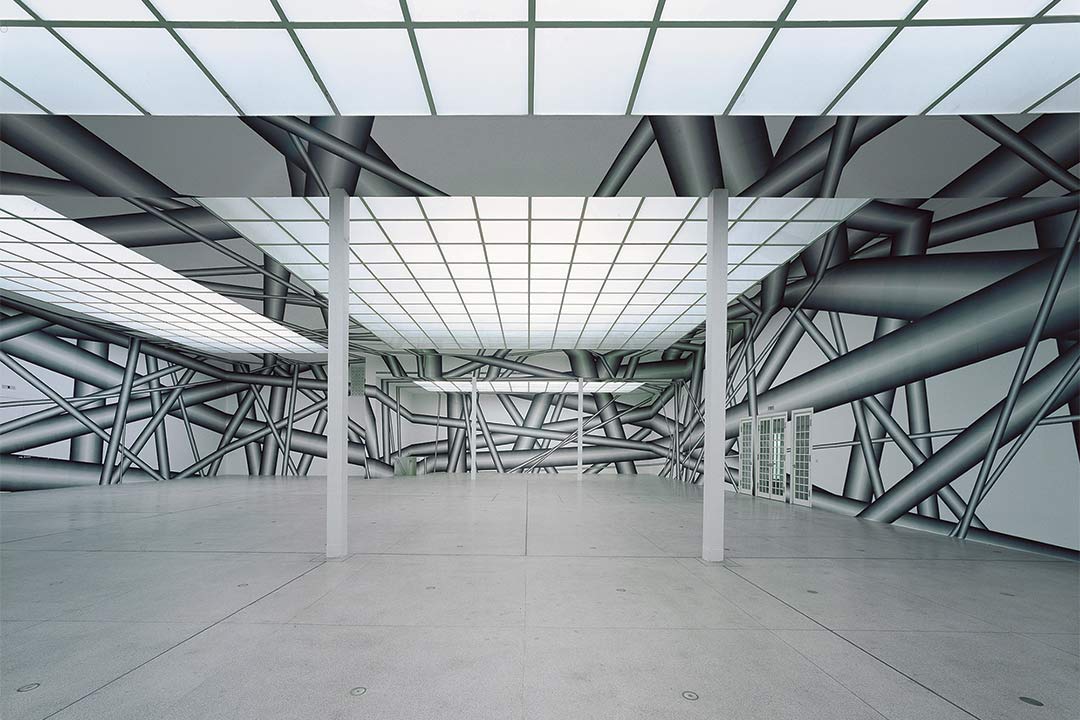
Podrecca: So even if a project breaks it, it starts from the position of actual space. In the shaping of space, a topic is also presented with a shell and a core. On one hand, there is the baroque principle; the estrangement, the augmentation, the deepening of space, the musculature of space, we could put it. On the other hand, you also create usable items, something between the work of art and the object. The shell and the core principle are noticeable. In the installations you place the observer in the centre of action, where there is the option to participate, also haptic; there is a desire to push the falling pipe. You provoke the desire to touch, to participate and, at the same time, you create a passe-partout for the items. So there is always the zone of tension between the profane and the dignified, the baroque. It is not something we can see every day – that is what I am interested in your work. When did you start formulating the shell and the core?
Kogler: This architectural aspect, in relation with spaces and buildings, emerged in the 1980s. More precisely, at the end of the 1980s, when I made the pictures – the objects, then I started upholstering the walls, and the pictures were hanged on them, so that they were expanded into space.
Podrecca: First there was space, and then the object?
Kogler: The frame of the painting is the meeting point of architecture and the painting. It was the topic back in the 1980s, this interest in the relation between the painting and the illusionistic space which defines the painting, and the actual space we are situated in.
Grimmer: Is it connected with your studies of scenography?
Kogler: Rather with my interest in American art, principles of Minimal Art, artists like Donald Judd or Sol LeWitt, the central figure in the art of wall treatment.
Grimmer: When we talk about persons significant to you, it is surprising, at first, that you mentioned Magritte, but then again perhaps not; it is about the creation of spaces which are unspecific, insecure, but also fascinating, even magical.
Kogler: Yes, of course, there is also the role of language. From all surrealists he was most conceptual in his work – the language, the images, the object.
Podrecca: When I look at Magritte’s paintings, his technique is not the first thing I see – I am surprised, shocked. When I saw your works for the first time, I was surprised. Where does the ant come from? When we get used to the motifs, the ant, the pipe… then there is the alphabet of terms, the catalogue which we can use or modify according to situation. The other stage of perception is the ability to apply what was implied as a surprise. What is the music of the singular, of the plural, of these different possibilities of application? Is surprise your conscious strategy, or did it developed spontaneously?
Kogler: When you talk about surprise in relation to Magritte, you refer to the surrealist aspect?

Podrecca: Female pyjamas have the shape of breasts in Magritte’s painting; that is the effect of shock.
Grimmer: It is also about emotion; physical feeling of the observer. I would like to mention the Pavilion of Prince Orsini at Bomarzo, which was reproduced in front of the building of the Vienna Künstlerhaus on the occasion of the Mannerism exhibition designed by Luigi Blau. All the walls in the interior were blue and slanted, visitors were dizzy, and the atmosphere was somewhat frightening. Can your work be connected with Mannerist tendencies? They were also opposed to the style.
Kogler: I have always liked Mannerism, for example, the small portrait of Parmigianino which is displayed here in Vienna. Many things which became important for Surrealism were discovered in Mannerism. Many aspects which became crucial for modern art of the 20th century were aspects of Mannerism. It is interesting that the same can be said for Surrealism and Constructivism.
Podrecca: Lawrence Weiner’s thesis comes to mind.
Kogler: You mean his notion that art can be constructed, fabricated, but even than it needs not be created and left formulated as a concept; all variants are equally valuable.
Podrecca: When we observe your presentations of the brain, of the networks you created, for which I earlier said that they were the demarcation line between art and science, a question arises whether you would be interested to shape a space with the help of a robot? An additional step in the sequence of art and science. According to the string theory the real world, and not the imaginary, artificial world, consists of strings. Would you be interested in jumping out of this artificial world?
Kogler: It is always interesting to work with the institutions which have these technical possibilities. In the 1990s I worked on a project labelled Cave, it was the first interactive Computer Environment. A visitor moved in space with 3D glasses on, and was under the influence of space. I worked with Ars Electronica Center in Linz back then; it was a laboratory of sorts that I could use whenever I wished, it was great. It is all possible if you can work with a partner who has technical possibilities, when you work in a studio, it is not possible. It is interesting if you can work with someone, but that, naturally, depends on the projects. Technology is interesting only to an extent, in relation to specific programmes. Good art rarely results from festivals which are extremely technical. The best results come from the people who work on art projects for a longer period of time, which are then compatible with specific media.
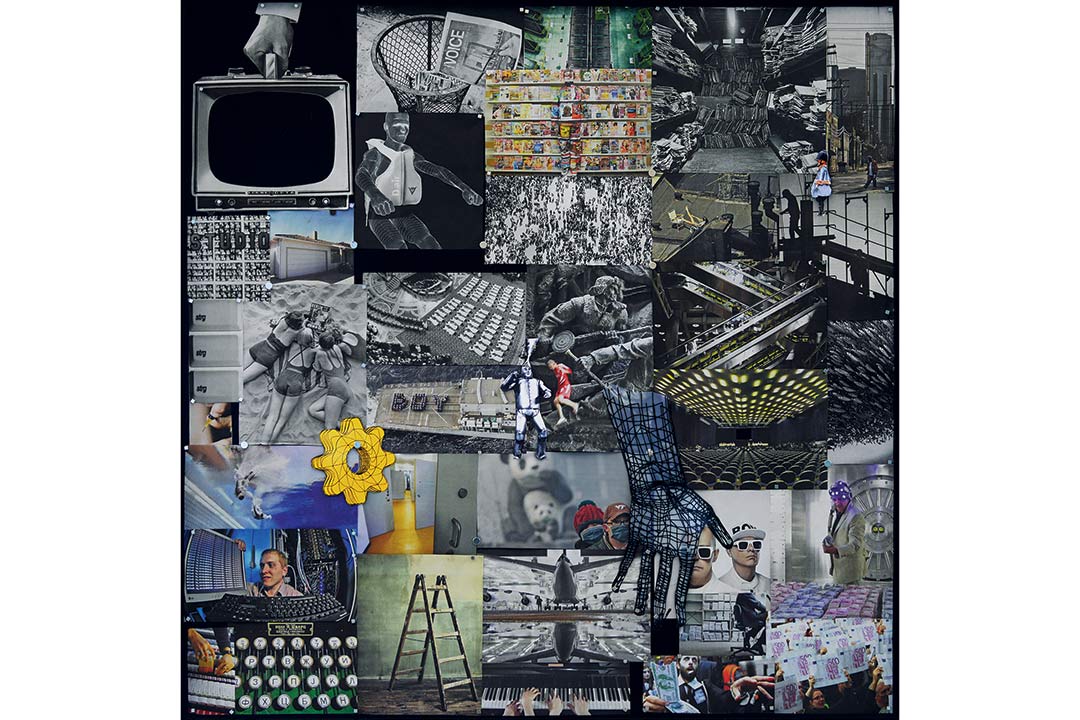
Podrecca: You also do collages. Collage is an old technique, dating back practically to Gutenberg; from calligraphy, ornament and other techniques to the information carrier. Your collages are basically mosaics, compositions of information carriers which stimulate you, but need not necessarily have a common context.
Kogler: We talked about the vocabulary I developed, which is transparent and consists of perhaps 10 or 15 modules, signs; it is one side of my work, the intensive shape of selections and limitations. On the other hand, in the last couple of years I began working on a series of works, wherein I do something completely opposite. I start by applying as much information as it is possible on the surfaces. These are the images I cut from newspapers; download from the Internet, everything which we are confronted with every day. In a way we all function as a filter; this stream of information goes through us; some things are then found in the short-term memory, and some in the long-term memory. It is interesting to see that we are thus conditioned. It was interesting for me to learn what often occurs with me; this is surprise and self-reflection.
Podrecca: This mosaic of information that you collect from various media sources, the digitalisation; is it just a transcript of reality that you deposit with the help of the system of connection, or is there a kind of social criticism in the background; a different level, which is not only visual, informative?
Kogler: I cannot say; it will probably become clear through the activity itself. The basic idea was that the confrontation with information has significantly radicalised during the last couple of years. Details reveal how radically our everyday life has changed in the last decade as a result of new media. Have a look at how you spend your typical working day – do you read e-mails when you come to the bureau, does your working day start that way? How much time do you spend dealing with information? Then there are the newspapers, then you have to watch football; it is all a continuous process of absorption.
Podrecca: I have numerous e-mails to read. The fact is also that everything is possible, anything goes, and at the same time.
Kogler: It is a new, important, and radical aspect of our culture.
Podrecca: It is about the divergence of motifs; there is no order. In this mass of motifs they explode simultaneously, in the same place. A classic cubistic collage is used for what an oil painting was not able to do. Elements of reality have been collaged so that an object is deconstructed; this has become a trendy word nowadays, let us use shattered instead.
Grimmer: It is also the montage of attractions, as with Eisenstein. Opposites are connected, and it leads to a new expression.
Kogler: The Russians were especially influential at that part of the 20th century; Rodchenko, Eisenstein, Mayakovsky in literature…
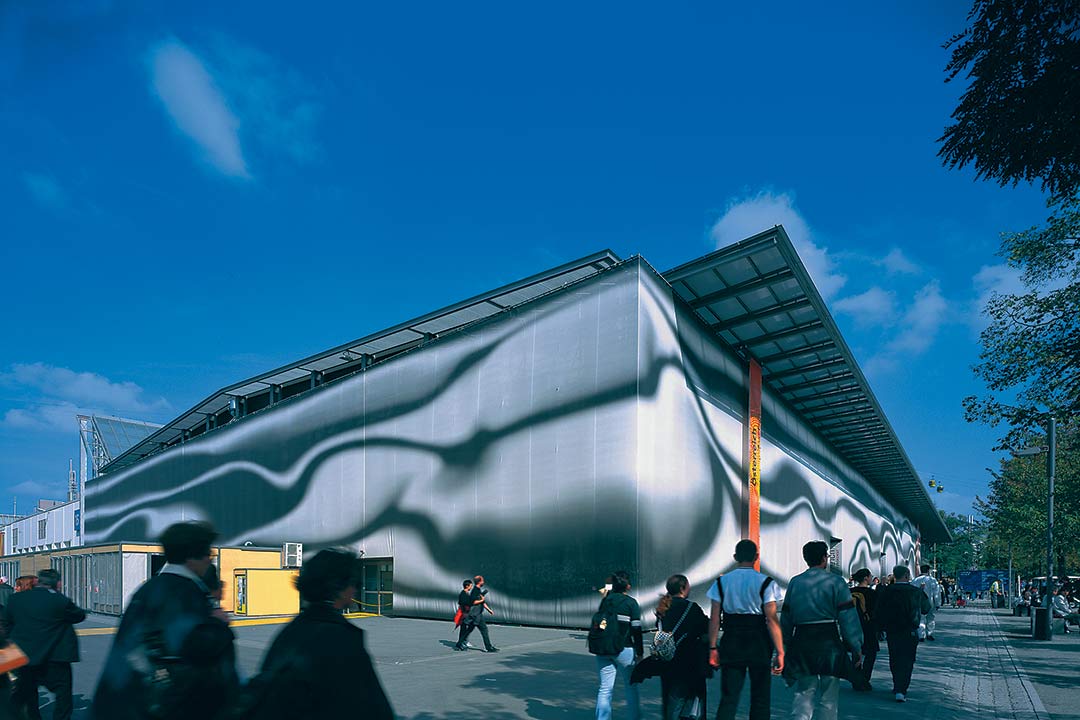
Grimmer: You work with architects – what do these processes look like? Is it about interaction or creating the conditions? For example, the collaboration with Dominique Perrault in Innsbruck, or your current cooperation in Naples. How does it happen?
Kogler: It is actually always about dialogue. We talk about structures, about given characteristics, about what we can do, and which media are the most effective.
Podrecca: Naples is specific, I have never done anything like that before; we are building under water; we are actually building a submarine. Peter basically dissolves the matter when you enter the area, there is no wall on the left, or on the right; there are no boundaries, no borderlines. These fluid elements create an undefined, endless area. Architectural and artistic intentions overlap here.
Kogler: The space is enormous, 90 m long and 25 m high; we have used biomorphic shapes.
Podrecca: It takes art; I cannot achieve it with my facilities. I did not want something trivial, Transavanguardia, divers, or the submarines. That brought me into conflict with the curator Bonito Oliva; I told him that I was sorry, but that it was not my world; that I needed the abstraction. It is important that art is not just a glued postage stamp. The whole project represents the biggest European museum, with the works of Kentridge, Pistoletto, Kounellis, Bob Wilson and many other artists. It is not just an area that you simply go through; it is also an area that you observe. You do not have to fall on your knees in front of a work of art; it is perceived in a specific tempo of arrivals and departures. It is enough for the area which you go through.
Kogler: I have noticed that when I participate at exhibitions, like Documenta, I always remain in the entrance hall, on the staircase; very rarely at the typical exhibition area. It probably depends on my work, which is quite significant information, which can be relatively quickly perceived. If we transfer this to the structures of the city, those become railway stations, subway stations; simply city synapses wherein traffic roads and information channels connect.
Grimmer: The public is also important; such interventions have a very wide influence.
Kogler: The vocabulary which does not require an educated audience is applied.
Podrecca: Art without a degree, so to say, not in a negative sense; perception is very brief, you need to react. The signs have to be relatively intensive; they have to have an element of shock – otherwise they are not noticed. Since I cannot achieve this as an architect, I need an artist, not to fasten a tie on a suit, so to say, but to be able to realise a specific architectural purpose – to expand a space, change a space and other spatial categories by a parallel expression of art and architecture. Your work can be characterised by certain perfection; your place resembles a pharmacy. Perfection also has an aesthetic charm. Is there anything which would resemble a generator of coincidence in your work? Is there a moment wherein a pure coincidence generates an image?
Kogler: I think this is always the case, because this is the way we work; we react in the heat of the moment. It is hard to say what is coincidental, and what is conditional. The digital system is so complex; you can leave at any junction, press any button.
Podrecca: Do you ever have any expectations when you are creating something, only for the generator of coincidence to change them?
Kogler: Yes, because we create works of art; otherwise we could only limit ourselves to a concept. While you are completing something you see whether it suits a purpose, and whether there was a mistake that needed to be fixed.
Podrecca: The line is very thin; sometimes, when I draw in pencil, I get a call, my hand swerves, and, unexpectedly, a new line is created. Coincidence generator is desirable; it cannot be bad, it is either good, or indifferent. There are similarities with the digital system; while technology is, definitely, completely different.
Kogler: They are enormous in such a complex digital system. There are numerous possibilities, and we are very slow; we need time to understand.
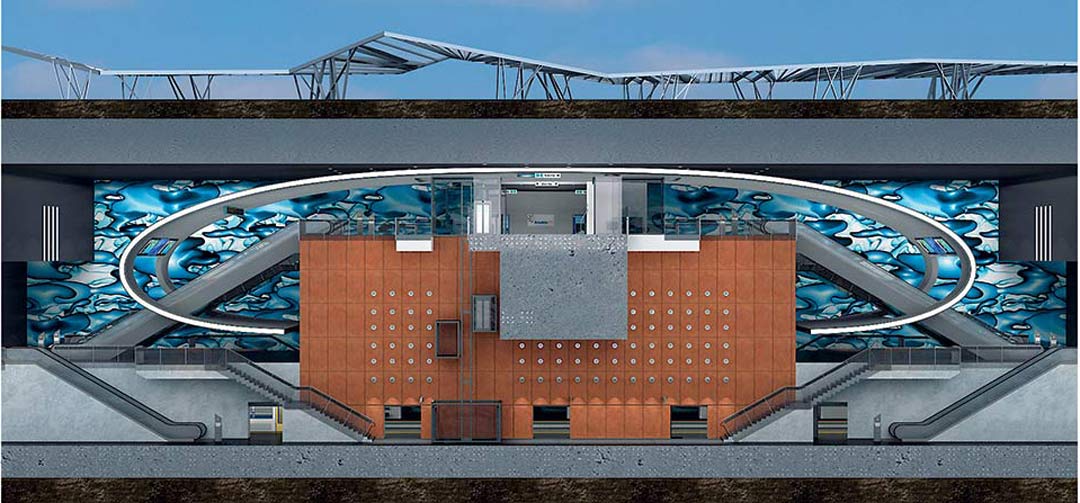
Podrecca: You told me that you draw, as well.
Kogler: I have always been drawing.
Podrecca: You used to draw parallel with the computer system.
Kogler: I only drew on screen before, nowadays I mostly draw on paper; the two run in parallel, it also depends on the medium. I really think that a drawing is as valuable as an installation, or a projection. It is important to do everything simultaneously because one media influences the other. When I make a drawing, I transfer it into a digital system. My work with wallpaper, for example, resulted in the possibility of putting space into movement in a specific moment. Animation could be constructed as wallpaper, with the left and the right edge matching.
Grimmer: The sound started to accompany your installations sometime around 2000.
Kogler: Always in collaboration with another colleague artist. Most often it is Franz Pomassl, he works with sound; it is his medium. I made projections with no sound, it works with specific motifs. With other motifs the accompanying sound has more sense; the picture and the tone suit the medium better. It was important that a professional made it.
Podrecca: I was impressed by Herbert Silberer’s book, he was Freud’s pupil. He formulated a fine distinction – the same in the other vs. the other in the same. For example, Morandi painted bottles his entire life; that is the same in the other. What you are doing is the other in the same.
Kogler: You are referring to the continuous vocabulary during a long period of time?
Podrecca: You use the variants of the same topic. Something new always occurs, but you use these elements depending on the location, on your mood, or a planned expression. It is the other compared with the artists who always produce the same. That apriorism is, naturally, very good. Marino Tartaglia’s View through the Window is an endless variation of one and the same thing.
Grimmer: Julije Knifer’s work as well.
Podrecca: Absolutely, that is an excellent example. I think that the principle of the other in the same applies to Peter. The poetics is one, but the consisting elements are different. It can very often be attributed to the architects, as well; Mario Botta always produces variants of the same.
Kogler: I think that we have returned to the issue of art and science. It is about a limitation to a specific vocabulary. On the other hand, I always do series. The process is serial; in a way analogous to the work in the laboratory. You simply have a specific number of parameters you use; you observe what happens, the way it looks. You try to maintain a certain level of control over your activity, coincidence always plays a role of its own. If you change too many parameters at the same time, you can no longer determine what is leading you in a specific direction. I do not like to create the same installation twice, because I already know the way it will look, but also because of a certain amount of egotism; I would rather invest my time into something which has an element of surprise.
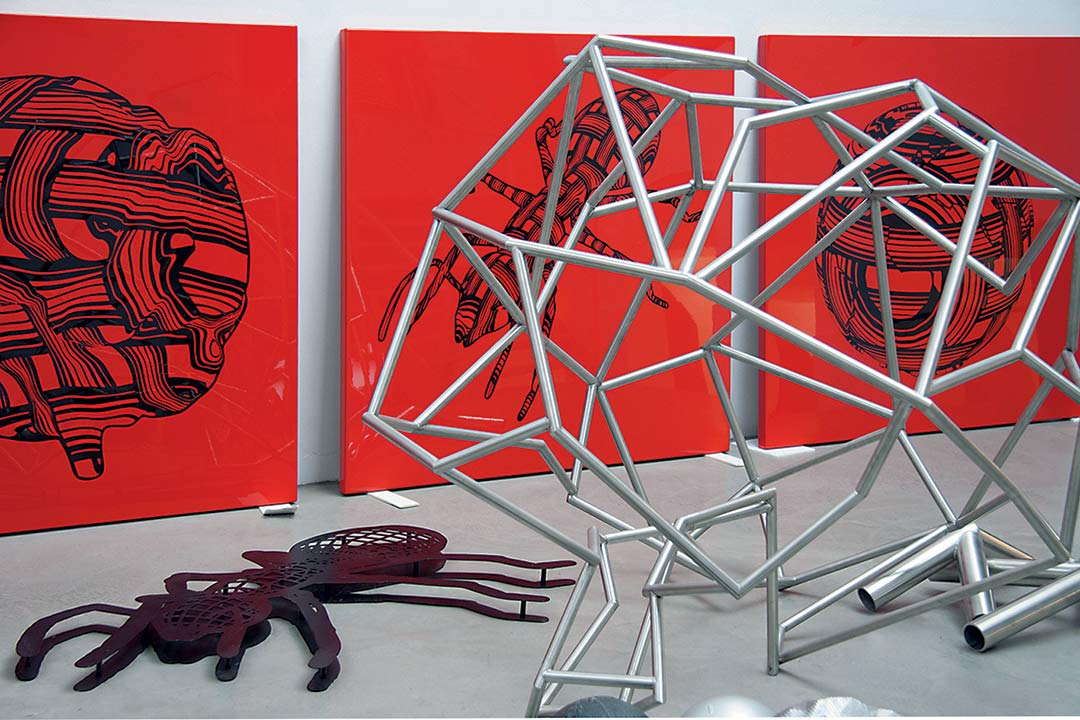
Grimmer: A question about your exhibition which will soon be opened in Zagreb; do you already have a concept of how space in the Museum of Contemporary Art, where the exhibition will take place, will be shaped? The rooms of the Museum are very functional.
Kogler: I like that very much. We will do a lot with space. We will occupy the highest level. At the same time on the floor below there will be an exhibition of a Lithuanian artist. The highest level is huge.
Grimmer: Do you have access to the façade? The media façade is the best part of the museum; it opens up to the city. Thousands of people can see it.
Kogler: Yes, it is great. There are these big avenues; the media façade can be seen from the crossroads. The exhibition will open on the 18th December. The wallpaper will be presented in the large part of the space, collage will be displayed in another, much information will be presented in a cabinet manner, and projections will be shown in yet another large area.